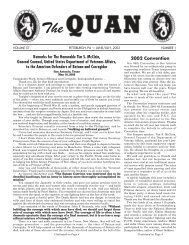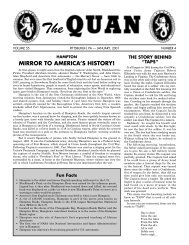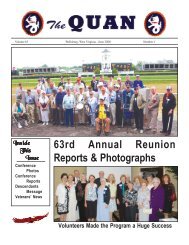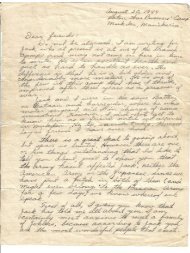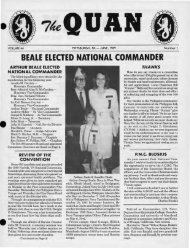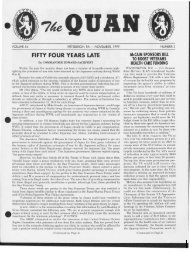Sept. 2003 - Philippine Defenders Main
Sept. 2003 - Philippine Defenders Main
Sept. 2003 - Philippine Defenders Main
You also want an ePaper? Increase the reach of your titles
YUMPU automatically turns print PDFs into web optimized ePapers that Google loves.
camouflaged them. In the late afternoon, the passengers<br />
returned and Filipinos began to ferry them in small boats back<br />
to the planes. The wind had increased, causing whitecaps on<br />
the lake’s surface. Soon, however, everyone was inside, waiting<br />
for darkness and the final departure in their long voyage.<br />
The pilots in one seaplane revved their engines. The plane<br />
skimmed the lake waters but did not lift off. They turned and<br />
tried again. Nothing happened. On the third take-off attempt, the<br />
seaplane glided the whole length of the lake before lifting into<br />
the air. The craft began to circle overhead in a holding pattern<br />
to wait for the other aircraft. [Hours later, crewmen discovered<br />
two stowaways who caused the increased weight and difficulty<br />
on getting airborne. The nurses heard the two were later<br />
returned to active duty.]<br />
Meanwhile, the gusts and waves blew the other seaplane<br />
towards the shoreline. Inside, Sally Blaine and her friends<br />
remained eerily calm. Nobody talked about their fears.<br />
Lieutenant Pollack tried to guide the plane toward a takeoff<br />
position but it kept drifting into shallow water.<br />
A Filipino watching the struggle offered to help and soon<br />
attached a tow line from his motorized outrigger to try to steer it<br />
into deeper water, but his small boat could not lead the large<br />
plane. The crew cut the line and pushed away overhead tree<br />
limbs as the craft drifted closer to the shore.<br />
After what seemed to her to be a long time, Sally heard a<br />
crunching sound. The plane shuddered violently. A submerged<br />
rock was tearing a hole in the seaplane. To Rita Palmer, another<br />
Army nurse on board, it looked as though a can opener was<br />
slicing through the hull. Water began to push inside.<br />
hrapnel wounds in her nose, arms and legs and a punctured<br />
left eardrum from a Japanese bombing of her Bataan hospital,<br />
Rosemary took off her terry cloth jacket and shoved the<br />
coat into the gaping opening. Other passengers gave her their<br />
sweaters and clothes. Sally watched the scene which reminded<br />
her of Hans Brinker’s tale about the boy who stuck his finger in<br />
a leaking dike.<br />
Lieutenant Pollack turned the seaplane into the wind. He<br />
planned to taxi into the deep part of the lake for take off. This<br />
action only caused a stronger rush of water. A quickly rising<br />
water level forced Rosemary Hogan to give up her effort.<br />
The pilot now realized he was not going to succeed on that<br />
windy, black night. He signaled the other seaplane to leave.<br />
Sally and the others on board sadly heard the sound of the<br />
motors from the airborne seacraft grow fainter.<br />
An Unfortunate Decision<br />
Pollack and his co-pilot maneuvered the damaged seaplane<br />
next to a makeshift wharf. With water ankle deep inside<br />
the cabin, Sally stood on her seat and waited her turn to exit.<br />
The passengers hurried outside without their belongings.<br />
The officers, ten military nurses, and three civilian women<br />
walked up a long, narrow, winding trail to a bus which took them<br />
back to Dansalan. About 2:30 a.m. on May 1 [261 Stranded Nurses on Mindanao<br />
(Continued from Page 11)<br />
⁄2 hours after<br />
leaving Corregidor], they walked into the same hotel where they<br />
had spent the previous day. Only this time they were wet, tired,<br />
hungry, and discouraged.<br />
The group dried their clothes, ate, and drank hot coffee,<br />
then looked for floor space or a bed to rest. Sally slept poorly<br />
that night wondering about her uncertain future. Neither she nor<br />
any other army nurse panicked or cried over their predicament.<br />
They were too emotionally and physically exhausted to react<br />
with much fervor, and, calamity was nothing new to them. From<br />
the beginning days of the Japanese offensive the previous<br />
December, they had witnessed a series of disasters, including<br />
the unexpected destruction and evacuation of their military<br />
bases, and the collapse of Allied resistance in the Bataan jungle.<br />
Every time these nurses had faced a debacle, they had<br />
managed to adjust and survive. As unnerving as the night on<br />
Lake Lanao in the damaged seaplane had been, it was another<br />
14 — THE QUAN<br />
setback. They were confident that somehow a plan would<br />
emerge.<br />
Colonel Stuart Wood, the senior officer, assisted by two<br />
other officers, assumed command in the stranded group.<br />
Although the nurses and the men were from different military<br />
units, protocol determined that the highest ranking officer would<br />
take the leadership position. [The nurses held the relative ranks<br />
of first and second lieutenants.] Wood told the women he<br />
believed that the seaplane was unsafe. He did not want to send<br />
anyone into the hills where Filipino and American guerrillas<br />
operated. Instead, he intended to find a place where they could<br />
hide together until General MacArthur sent a rescue plane or<br />
boat from his headquarters in Australia. Everyone agreed. They<br />
soon left the hotel in their bus and headed toward a nearby Del<br />
Monte pineapple plantation. The manager there had heard<br />
about their plight and offered them temporary refuge.<br />
Meanwhile, back on Lake Lanao, Lieutenant Pollack<br />
believed he could repair his damaged plane. A Navy boat crew<br />
and a Navy salvage expert appeared on the scene to help.<br />
Together they covered the gaping hole, baled the water, and<br />
removed all luggage and possessions to lighten the aircraft. By<br />
4 p.m. the aircraft was ready for takeoff, however, Pollack could<br />
not find his passengers. The sailors informed him that the<br />
Japanese were less than twenty miles away. They had no time<br />
to look or wait. Pollack, his crew, and the Navy men lifted off<br />
Lake Lanao. Hours later they safely landed in Australia near the<br />
other seaplane which also had successfully made the flight. The<br />
ten Army nurses on that craft were unharmed and resting in a<br />
hospital.<br />
Looking back on that fateful day and the decision that had<br />
sealed her destiny, Sally Blaine said, “There was never any criticism<br />
… I think Colonel Wood was right. If we had gone on it<br />
[the seaplane] and been killed, they probably would have courtmartialed<br />
the poor man.” To this day, however, Pollack has<br />
regrets about leaving the nurses behind.<br />
On Corregidor, General Wainwright received word about<br />
the stranded passengers. In his memoirs, he recorded his reaction,<br />
“A tragic farewell … [to] a number of nurses who richly<br />
deserved a better fate.”<br />
An Odyssey on Mindanao Island<br />
Although the Del Monte pineapple plantation had served as<br />
a stopover for General MacArthur on his escape to Australia<br />
two months earlier in March 1942, and the plantation had provided<br />
a temporary headquarters for Allied forces on Mindanao,<br />
tensions between the passengers and the plantation manager<br />
became so great that the group spent only one day at the plush<br />
site. Sally Blaine remembered the manager as a nasty man<br />
who did not want to take care of so many people. Another possible<br />
reason for the friction was that the civilian businessman<br />
knew how near the Japanese were to his plantation and he did<br />
not want military officers in his midst.<br />
The Americans returned to their vintage bus at dusk and<br />
left the pineapple groves. The vehicle did not have the engine<br />
power to climb Mindanao’s hills, so when the driver reached the<br />
bottom of an incline, he stopped and everyone got off. The<br />
weaker and sicker women, like Sally Blaine, walked alongside<br />
while the men and stronger women helped push the bus uphill.<br />
The work of getting themselves and the vehicle up the hills<br />
seemed to boost morale. Sally watched the injured nurse<br />
Rosemary Hogan nudge the bus, and thought that if her friend<br />
was not going to give up, neither would she.<br />
In the six months since the war began, Sally and the other<br />
women had formed a solid group similar in spirit to the dynamics<br />
that occur among men in fighting units. The long distance<br />
from home and the intensity of the Japanese strikes had forced<br />
them to turn to one another for physical and emotional support.<br />
The nurses on Mindanao: Earleen Allen, Louise Anschinks,<br />
Agnes Barre, Sally Blaine, Helen Gardner, Rosemary Hogan,<br />
Geneva Jenkins, Rita Palmer, Eleanor “Peg” O’Neill, and<br />
Evelyn Whitlow, continued to help one another.<br />
(Continued on Page 15)




